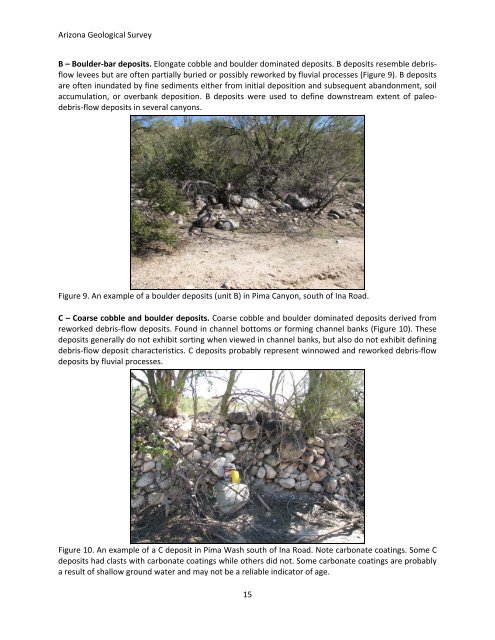Arizona Geological Survey OPEN-FILE REPORT OFR 08-06
Arizona Geological Survey OPEN-FILE REPORT OFR 08-06
Arizona Geological Survey OPEN-FILE REPORT OFR 08-06
You also want an ePaper? Increase the reach of your titles
YUMPU automatically turns print PDFs into web optimized ePapers that Google loves.
<strong>Arizona</strong> <strong>Geological</strong> <strong>Survey</strong><br />
B – Boulder‐bar deposits. Elongate cobble and boulder dominated deposits. B deposits resemble debrisflow<br />
levees but are often partially buried or possibly reworked by fluvial processes (Figure 9). B deposits<br />
are often inundated by fine sediments either from initial deposition and subsequent abandonment, soil<br />
accumulation, or overbank deposition. B deposits were used to define downstream extent of paleodebris‐flow<br />
deposits in several canyons.<br />
Figure 9. An example of a boulder deposits (unit B) in Pima Canyon, south of Ina Road.<br />
C – Coarse cobble and boulder deposits. Coarse cobble and boulder dominated deposits derived from<br />
reworked debris‐flow deposits. Found in channel bottoms or forming channel banks (Figure 10). These<br />
deposits generally do not exhibit sorting when viewed in channel banks, but also do not exhibit defining<br />
debris‐flow deposit characteristics. C deposits probably represent winnowed and reworked debris‐flow<br />
deposits by fluvial processes.<br />
Figure 10. An example of a C deposit in Pima Wash south of Ina Road. Note carbonate coatings. Some C<br />
deposits had clasts with carbonate coatings while others did not. Some carbonate coatings are probably<br />
a result of shallow ground water and may not be a reliable indicator of age.<br />
15
















